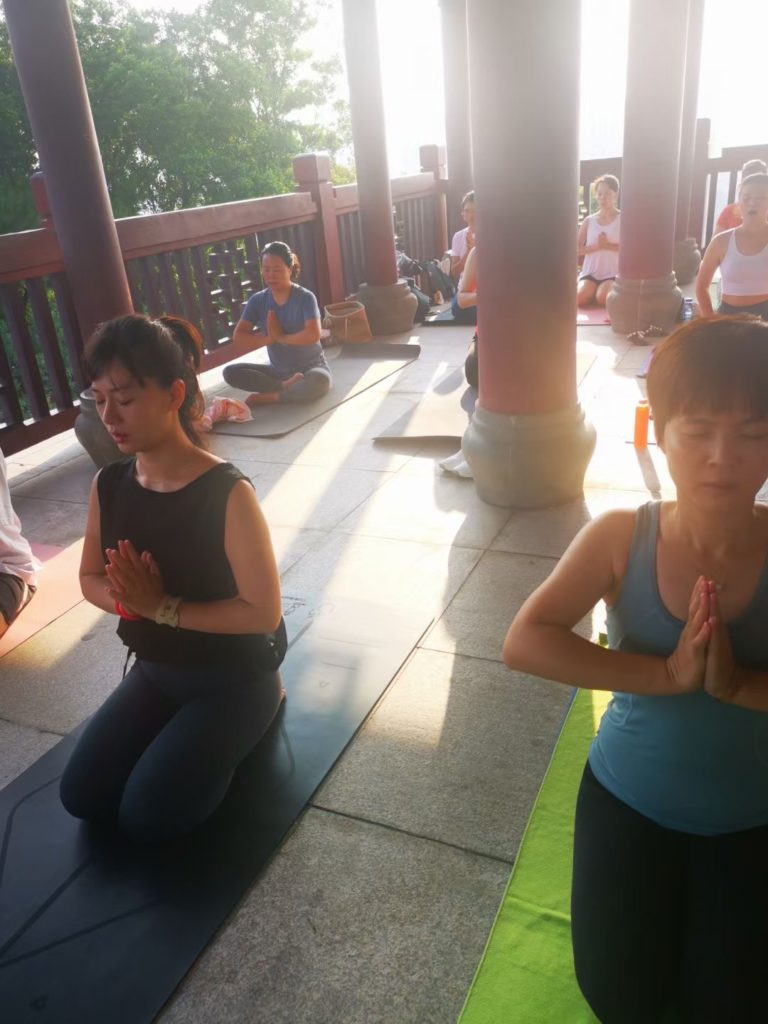Speech from Chen Ya, Anusara’s Official Representative in China
Categories: Asia Pacific, News
(translated by Alyssa Li, China Liaison, Anusara School of Hatha Yoga)

What is Anusara Yoga?
Tonight I will give you just a very brief introduction of Anusara Yoga. Open to Grace is the official expression. However, many of you wonder how it works. I believe my story may tell you a little bit.
I started practicing Anusara in 2008 when it was the darkest time of my career. I got hurt physically and mentally in my teaching and practice of Yoga. I joined a Yoga teacher training course in 2005 and started my Yoga teaching career at age of 40. I knew the only way to get success at a later age was to make great effort. So I worked very hard. I went all out in my practice with the effort of climbing the summit of the Himalayas. It was the earliest time of Yoga in China with very little introduction of anatomy. I got injured because of blind and hard practicing. In those days I came up with the idea that I should not continue teaching at such a challenging career. I started to wonder where I should go. Should I change to another kind of Yoga, like Yin Yoga?
At this critical moment I met Anusara Yoga. I remembered my first Anusara class. Ms. Louis shared with us a main theme: Open to Grace, it means life is a gift. I was so touched, and my tears kept running. I could not tell what that kind of feeling was, but I started to fall in love with it. Thanks to my very first teacher who led me home. From then on I kept on my yoga practices with the five Anusara Universal Principles of Alignment, which I felt were a great difference to my previous yoga training. It made me feel like I was holding onto a walking stick while climbing a mountain. It gave me great support for my teaching as well. Amazingly, after some time, my bodily pain disappeared, and I felt relaxed. This had provoked my interest in going deeper into its Tantra philosophy.
How can the five Universal Principles support your yoga practices and daily life?
For those who have learned about Anusara, they know well that this system consists of five universal principles. I would like to share with you some of my personal understanding as to what way the principles help in your yoga practices and life.
First of all, the five principles work like the classical sutra. What is classical sutra? They must be some words and wisdom that had been approved to be some kind of truth for thousands of years. They are different from novels or prose essays which reflect the author’s emotion at most. We Chinese have <Tao Te Ching>, the great sutra by Laozi , with only five thousand words but to be studied from generation to generation. Yoga Sutra is one of the classical books recommended by one of my teachers, Mr. Liu Hongming. He said that the Yoga Sutra helped him to turn over his life from dark to bright. He has also succeeded in opening classes like “Introduction the wisdom of Yoga Sutra” and “Make order in three minutes”. I should say that the five universal principles are incomparable because they can apply to all yoga practices. You can find that many of the functional yoga nowadays have very different ways of doing, but none of them include the five principles. I remembered I took part in almost all workshops by foreign yoga teachers running in China from 2005 to 2008. I cherished every moment of the class with an open and modest heart. I took notes and tried to remember every word the teacher used in asana. One of the teachers described that he can see the fire in my eyes. The frequent training gave me something new in my teaching; however, I felt while when I learned something new, I dropped the previous knowledge. They are so different that I could not put them together in my teaching. Just like pearls without sutra, you cannot take them as a necklace. Only when I discovered Anusara, the five principles came to me: the great pearls. I made them a beautiful necklace and enjoyed every one of them as I wished.
So I came to realize that there is a system in Anusara. Using the five principles in teaching as a system, it is clear the problems students have focusing on the whole body movement and not just the surface of the wrong movement. Besides, I really enjoy the inclusiveness of Anusara; it teaches me to respect the differences of every individual. I have always asked my students to understand their own blueprint and hold within their ability.
Among the five principles, I like the first one most – open to grace. It teaches us that life is full of grace. Take Downward Facing Dog, for example. We can see many students look like [out of alignment]. As a teacher you may give an order to request an adjustment as quickly as possible even though the student is not able to do it. Well, Anusara teachers may give the order in different ways, with the steps of each principle. We may look at the foundation to see if the foot and hand are solidly grounded and [the student is] breathing well….The second thing is to collect the muscular energy from three directions. It shows a strong and steady pose with energy drawing to the energy center. Then comes the third and four which are called the inner spiral and outer spiral. I will give up these two since they are a little bit complicated.
Now we go ahead to see what happens with the five principles of expanding energy. It looks so comfortable and enjoyable. When the student extends out from the focal point of the heart, energy spreads into all parts of the body….That is how the principles work step by step in every asana. It is running with a system.
How to apply the principles into daily life?
From what I have talked about above, you may agree Anusara is indeed a system. As a teacher you can have great support from it even when you deal with all kinds of people coming to your class–a beginner, an elderly person, an injured one, or someone for the beauty of legs or hip. The principles will help you to put your attention into not only what Asana works but how it works. You can be creative to address all issues.
Lastly, I would like to talk about the Tantra philosophy which I found fascinating and obsessed me greatly. The essence of Anusara Yoga is based on Tantra, one of the philosophies of Veda. Asana may in some way help you to get strong in body, but Tantra would be a true path to improve your body and heart as a whole. The fulfillment in life is something we are looking for. With the combination of “follow the heart” and “asana”, Anusara yoga shows its unique characteristic and its best way to help students to enjoy yoga exercise and soul nourishment. It has been a great challenge for me to prepare a special heart-focused course to match one of the principles in every class. But when I saw my students understood what I explained and enjoyed the class very much, I was happy and felt great satisfaction from teaching. I believe that Anusara yoga has helped in many ways to liberate people from different [kinds of] pain.
I have talked a lot about Anusara yoga. I am not sure how much you got from me. To sum up my speech, there are four points:
1. Tantra is the top guiding [philosophy] of Anusara and stands for the top issue in life.
2. With five principles as skill and Tantra as a heart theme, these make Anusara very special and unique and warmly received by participants.
3. Heart oriented is the most important feature.
4. Open to grace could easily touch people as this is a big issue nowadays for every one of us.




